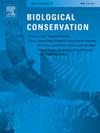Intense international exploitation of African hornbills necessitates urgent conservation measures, including CITES listing
IF 4.9
1区 环境科学与生态学
Q1 BIODIVERSITY CONSERVATION
引用次数: 0
Abstract
Unchecked international trade in wildlife threatens biodiversity globally. The major mechanism for regulating this trade is listing species in the appendices of CITES, the Convention on International Trade in Endangered Species. However, piecemeal protection of species in decline can displace demand onto similar, unprotected species. In this study, we consider the case of the hornbills (Bucorvidae and Bucerotidae). Most Asian hornbills received CITES protection in 1992, while international trade in African hornbills remains unregulated and under-documented. We analyzed data collected by the US Fish & Wildlife Service on 573 shipments of at least 2704 hornbills from 1999 to 2024. African species accounted for 94.5 % of traded hornbills. Trade in African hornbills has increased significantly over time, unlike the trade volume of Asian hornbills, which has remained constant under CITES management. Larger forest hornbill skulls are often sold online as oddities, while the smaller species are advertised as pets. Current US trade in the larger African genera Ceratogymna and Bycanistes likely exceeds global trade in all Asian hornbills prior to their CITES protection. Trade in the already Vulnerable Yellow-casqued Hornbill and Brown-cheeked Hornbill currently poses an existential threat to these species. However, every African genus of hornbill is traded internationally. To avoid shifting demand onto a few remaining unprotected species, and to ensure that forest hornbills continue to play their critical ecological role as seed dispersers, we call for CITES parties to list the hornbill families in Appendix II at the next Conference of the Parties.

国际上对非洲犀鸟的大量开发需要采取紧急保护措施,包括列入CITES
不受控制的国际野生动物贸易威胁着全球的生物多样性。管制这种贸易的主要机制是将物种列入《濒危物种国际贸易公约》的附录。然而,对正在减少的物种进行零敲碎打的保护可能会将需求转移到类似的、未受保护的物种上。在这项研究中,我们考虑了犀鸟(布科和布科)的情况。大多数亚洲犀鸟在1992年获得了CITES的保护,而非洲犀鸟的国际贸易仍然不受管制和记录不足。我们分析了由美国鱼类研究所收集的数据。从1999年到2024年,野生动物管理局对573批至少2704只犀鸟进行了调查。非洲物种占交易犀鸟的94.5%。随着时间的推移,非洲犀鸟的贸易量显著增加,而亚洲犀鸟的贸易量在CITES的管理下保持不变。较大的森林犀鸟头骨通常作为奇形怪状的东西在网上出售,而较小的物种则被宣传为宠物。目前美国对较大的非洲犀鸟属和犀鸟属的贸易可能超过了在CITES保护之前所有亚洲犀鸟的全球贸易。对已经脆弱的黄颊犀鸟和褐颊犀鸟的交易目前对这些物种的生存构成了威胁。然而,每一种非洲犀鸟都在国际上进行交易。为了避免将需求转移到少数未受保护的物种上,并确保森林犀鸟继续发挥其作为种子传播者的关键生态作用,我们呼吁CITES缔约方在下次缔约方大会上将犀鸟家族列入附录II。
本文章由计算机程序翻译,如有差异,请以英文原文为准。
求助全文
约1分钟内获得全文
求助全文
来源期刊

Biological Conservation
环境科学-环境科学
CiteScore
10.20
自引率
3.40%
发文量
295
审稿时长
61 days
期刊介绍:
Biological Conservation is an international leading journal in the discipline of conservation biology. The journal publishes articles spanning a diverse range of fields that contribute to the biological, sociological, and economic dimensions of conservation and natural resource management. The primary aim of Biological Conservation is the publication of high-quality papers that advance the science and practice of conservation, or which demonstrate the application of conservation principles for natural resource management and policy. Therefore it will be of interest to a broad international readership.
 求助内容:
求助内容: 应助结果提醒方式:
应助结果提醒方式:


